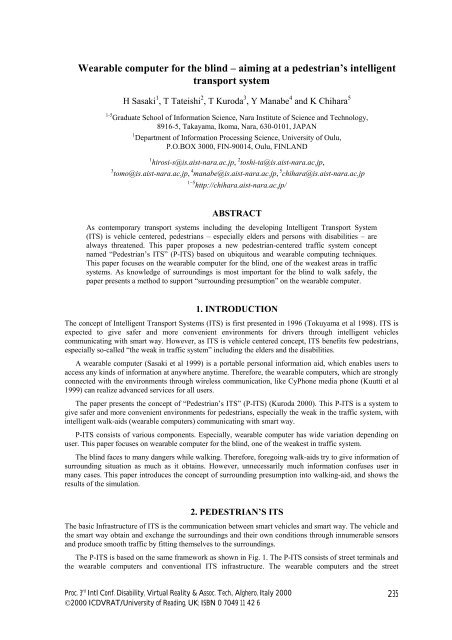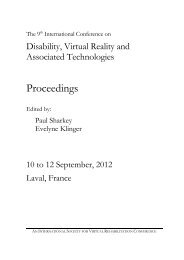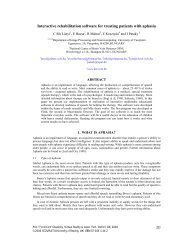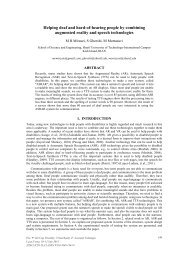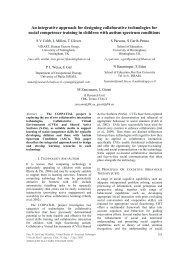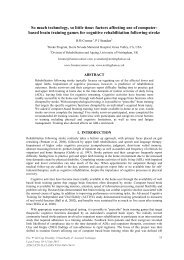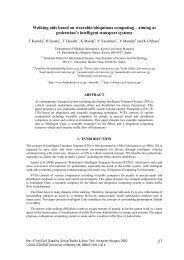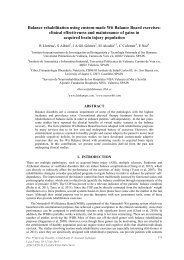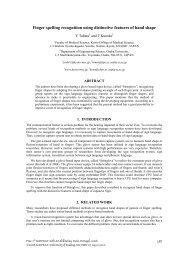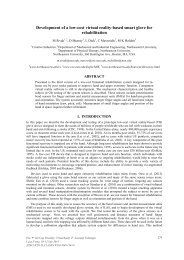Preparation of papers in single column format - ResearchGate
Preparation of papers in single column format - ResearchGate
Preparation of papers in single column format - ResearchGate
You also want an ePaper? Increase the reach of your titles
YUMPU automatically turns print PDFs into web optimized ePapers that Google loves.
Wearable computer for the bl<strong>in</strong>d – aim<strong>in</strong>g at a pedestrian’s <strong>in</strong>telligent<br />
transport system<br />
H Sasaki 1 , T Tateishi 2 , T Kuroda 3 , Y Manabe 4 and K Chihara 5<br />
1-5 Graduate School <strong>of</strong> In<strong>format</strong>ion Science, Nara Institute <strong>of</strong> Science and Technology,<br />
8916-5, Takayama, Ikoma, Nara, 630-0101, JAPAN<br />
1 Department <strong>of</strong> In<strong>format</strong>ion Process<strong>in</strong>g Science, University <strong>of</strong> Oulu,<br />
P.O.BOX 3000, FIN-90014, Oulu, FINLAND<br />
1 hirosi-s@is.aist-nara.ac.jp, 2 toshi-ta@is.aist-nara.ac.jp,<br />
3 tomo@is.aist-nara.ac.jp, 4 manabe@is.aist-nara.ac.jp, 5 chihara@is.aist-nara.ac.jp<br />
1−5 http://chihara.aist-nara.ac.jp/<br />
ABSTRACT<br />
As contemporary transport systems <strong>in</strong>clud<strong>in</strong>g the develop<strong>in</strong>g Intelligent Transport System<br />
(ITS) is vehicle centered, pedestrians – especially elders and persons with disabilities – are<br />
always threatened. This paper proposes a new pedestrian-centered traffic system concept<br />
named “Pedestrian’s ITS” (P-ITS) based on ubiquitous and wearable comput<strong>in</strong>g techniques.<br />
This paper focuses on the wearable computer for the bl<strong>in</strong>d, one <strong>of</strong> the weakest areas <strong>in</strong> traffic<br />
systems. As knowledge <strong>of</strong> surround<strong>in</strong>gs is most important for the bl<strong>in</strong>d to walk safely, the<br />
paper presents a method to support “surround<strong>in</strong>g presumption” on the wearable computer.<br />
1. INTRODUCTION<br />
The concept <strong>of</strong> Intelligent Transport Systems (ITS) is first presented <strong>in</strong> 1996 (Tokuyama et al 1998). ITS is<br />
expected to give safer and more convenient environments for drivers through <strong>in</strong>telligent vehicles<br />
communicat<strong>in</strong>g with smart way. However, as ITS is vehicle centered concept, ITS benefits few pedestrians,<br />
especially so-called “the weak <strong>in</strong> traffic system” <strong>in</strong>clud<strong>in</strong>g the elders and the disabilities.<br />
A wearable computer (Sasaki et al 1999) is a portable personal <strong>in</strong><strong>format</strong>ion aid, which enables users to<br />
access any k<strong>in</strong>ds <strong>of</strong> <strong>in</strong><strong>format</strong>ion at anywhere anytime. Therefore, the wearable computers, which are strongly<br />
connected with the environments through wireless communication, like CyPhone media phone (Kuutti et al<br />
1999) can realize advanced services for all users.<br />
The paper presents the concept <strong>of</strong> “Pedestrian’s ITS” (P-ITS) (Kuroda 2000). This P-ITS is a system to<br />
give safer and more convenient environments for pedestrians, especially the weak <strong>in</strong> the traffic system, with<br />
<strong>in</strong>telligent walk-aids (wearable computers) communicat<strong>in</strong>g with smart way.<br />
P-ITS consists <strong>of</strong> various components. Especially, wearable computer has wide variation depend<strong>in</strong>g on<br />
user. This paper focuses on wearable computer for the bl<strong>in</strong>d, one <strong>of</strong> the weakest <strong>in</strong> traffic system.<br />
The bl<strong>in</strong>d faces to many dangers while walk<strong>in</strong>g. Therefore, forego<strong>in</strong>g walk-aids try to give <strong>in</strong><strong>format</strong>ion <strong>of</strong><br />
surround<strong>in</strong>g situation as much as it obta<strong>in</strong>s. However, unnecessarily much <strong>in</strong><strong>format</strong>ion confuses user <strong>in</strong><br />
many cases. This paper <strong>in</strong>troduces the concept <strong>of</strong> surround<strong>in</strong>g presumption <strong>in</strong>to walk<strong>in</strong>g-aid, and shows the<br />
results <strong>of</strong> the simulation.<br />
2. PEDESTRIAN’S ITS<br />
The basic Infrastructure <strong>of</strong> ITS is the communication between smart vehicles and smart way. The vehicle and<br />
the smart way obta<strong>in</strong> and exchange the surround<strong>in</strong>gs and their own conditions through <strong>in</strong>numerable sensors<br />
and produce smooth traffic by fitt<strong>in</strong>g themselves to the surround<strong>in</strong>gs.<br />
The P-ITS is based on the same framework as shown <strong>in</strong> Fig. 1. The P-ITS consists <strong>of</strong> street term<strong>in</strong>als and<br />
the wearable computers and conventional ITS <strong>in</strong>frastructure. The wearable computers and the street<br />
Proc. 3 rd Intl Conf. Disability, Virtual Reality & Assoc. Tech., Alghero, Italy 2000<br />
©2000 ICDVRAT/University <strong>of</strong> Read<strong>in</strong>g, UK; ISBN 0 7049 11 42 6<br />
235
term<strong>in</strong>als communicate via short-range wireless communication, such as Bluetooth (Bluetooth 2000). The<br />
street term<strong>in</strong>als and the wearable computers obta<strong>in</strong> the surround<strong>in</strong>gs and its own or user’s conditions<br />
respectively, and exchanges them each other. The wearable computer navigates the user consider<strong>in</strong>g the<br />
<strong>in</strong><strong>format</strong>ion from street term<strong>in</strong>als and itself. On the other hand, the street term<strong>in</strong>al changes the traffic<br />
<strong>in</strong>frastructure such as traffic lights and mov<strong>in</strong>g walks depend<strong>in</strong>g on the <strong>in</strong><strong>format</strong>ion given by neighbor<strong>in</strong>g<br />
wearable computers. Through this configurations, the P-ITS provides some services for smooth and<br />
comfortable environment for pedestrians.<br />
The remarkable characteristic <strong>of</strong> this system is that the total <strong>in</strong>frastructure is applicable for other<br />
commercial and social applications not only for the disabled but also for any people. Therefore, the<br />
<strong>in</strong>frastructure can be realized under commercial requirements.<br />
Figure 1. The Infrastructure for Pedestrian’s ITS.<br />
3. TYPICAL SERVICE MODELS<br />
This section shows three typical service models available under P-ITS <strong>in</strong>frastructure.<br />
3.1 Expand<strong>in</strong>g “five senses”<br />
The audibly and visionary disabled people, <strong>in</strong>clud<strong>in</strong>g the elderly people, have a certa<strong>in</strong> amount <strong>of</strong> difficulties<br />
while they are walk<strong>in</strong>g, because they may lose fatal <strong>in</strong><strong>format</strong>ion such as noise <strong>of</strong> approach<strong>in</strong>g car. Therefore,<br />
various types <strong>of</strong> <strong>in</strong><strong>format</strong>ion and walk<strong>in</strong>g aid devices are developed. However, ability and sensor range <strong>of</strong><br />
such devices are hardly limited because the devices realize all sens<strong>in</strong>g, conversion, and display procedures<br />
with<strong>in</strong> its portable size body. Nevertheless, the devices are still too big and heavy to wear. Moreover, most <strong>of</strong><br />
them confuse its user by giv<strong>in</strong>g enormous raw data that is just a direct conversion <strong>of</strong> data obta<strong>in</strong>ed by certa<strong>in</strong><br />
sensors.<br />
P-ITS utilizes street term<strong>in</strong>als with certa<strong>in</strong> sensors, such as CCD cameras or microphones, as external<br />
sensors <strong>of</strong> pedestrian’s term<strong>in</strong>als. This service enables the hear<strong>in</strong>g impaired to know a bicycle or vehicle<br />
r<strong>in</strong>g<strong>in</strong>g his/her beh<strong>in</strong>d, and the vision impaired to know a obstacles <strong>in</strong> front <strong>of</strong> him as shown <strong>in</strong> Fig. 2. The<br />
street term<strong>in</strong>als around a certa<strong>in</strong> user can provide <strong>in</strong><strong>format</strong>ion, which a s<strong>in</strong>gle conventional walk<strong>in</strong>g aid<br />
device cannot. This means that a user can re<strong>in</strong>force his/her five senses by wear<strong>in</strong>g a gigantic aggregate <strong>of</strong><br />
sensors named “city”.<br />
236<br />
Proc. 3 rd Intl Conf. Disability, Virtual Reality & Assoc. Tech., Alghero, Italy 2000<br />
©2000 ICDVRAT/University <strong>of</strong> Read<strong>in</strong>g, UK; ISBN 0 7049 11 42 6
Figure 2. Expanded “Five Senses”.<br />
When all the street term<strong>in</strong>als provide obta<strong>in</strong>ed <strong>in</strong><strong>format</strong>ion directly to the pedestrian’s term<strong>in</strong>al, the flood<br />
<strong>of</strong> <strong>in</strong><strong>format</strong>ion may confuse user. The street term<strong>in</strong>als must presume surround<strong>in</strong>gs <strong>of</strong> the user cooperatively<br />
to give necessary and sufficient <strong>in</strong><strong>format</strong>ion to the pedestrian’s term<strong>in</strong>al. This “surround<strong>in</strong>g presumption”<br />
enables the user to pay much attention to other dangers and important affairs for his/her walk by outsourc<strong>in</strong>g<br />
a part <strong>of</strong> presumption process. Additionally, the <strong>in</strong><strong>format</strong>ion from various types <strong>of</strong> sensors <strong>of</strong> streets<br />
term<strong>in</strong>als and pedestrian’s term<strong>in</strong>al itself enable advanced circumstantial judgment, which a s<strong>in</strong>gle pedestrian<br />
term<strong>in</strong>al cannot realize.<br />
P-ITS enables the pedestrian’s term<strong>in</strong>als without many sensors and powerful processor to provide<br />
required <strong>in</strong><strong>format</strong>ion by outsourc<strong>in</strong>g the sens<strong>in</strong>g and process<strong>in</strong>g tasks. Hence, the pedestrian’s term<strong>in</strong>al can<br />
concentrate its computational power to provide better <strong>in</strong>terface for its user.<br />
3.2 Produc<strong>in</strong>g smooth traffic<br />
As develop<strong>in</strong>g ITS is vehicle centered system, ITS benefits few pedestrians. In order to provide truly barrierfree<br />
walk<strong>in</strong>g environment, pedestrian-centered reconstruction <strong>of</strong> whole traffic system is unavoidable.<br />
Global position<strong>in</strong>g system (GPS) term<strong>in</strong>al can navigate its user through barrier-free route, such as the<br />
stairs with escalator, and the pavements free from bumps. The extended five senses mentioned above may<br />
tell better route, which avoids the cross<strong>in</strong>g over heavy traffics and the crowded sidewalks. However, this<br />
approach cannot provide pedestrian-centered traffic system, as it requires the additional efforts <strong>of</strong><br />
pedestrians.<br />
P-ITS realizes pedestrian-centered traffic system with dynamic control <strong>of</strong> traffic <strong>in</strong>frastructure, such as<br />
traffic signals or mov<strong>in</strong>g walks. For example, a traffic light changes its duration <strong>of</strong> green light, and a<br />
escalator or a mov<strong>in</strong>g walk changes its direction when elderly people with difficulty <strong>in</strong> walk approach as<br />
shown <strong>in</strong> Fig. 3.Among this scenario, the traffic light control is partly realized (Nippon Road 2000).<br />
Additionally, the P-ITS may navigate pedestrians through pedestrian’s term<strong>in</strong>als to realize smooth traffic.<br />
For example, a certa<strong>in</strong> pavement can be divided <strong>in</strong>to several routes depend<strong>in</strong>g on the walk<strong>in</strong>g speed <strong>of</strong><br />
pedestrians. Like this example, cooperation among term<strong>in</strong>als may provide better environments for<br />
pedestrians.<br />
The “extended five senses” service mentioned <strong>in</strong> section 3.1 is realized on the passive usage <strong>of</strong> the P-ITS<br />
<strong>in</strong>frastructure. On the other hand, the “promot<strong>in</strong>g smooth traffic” service provides barrier-free environment<br />
and efficient use <strong>of</strong> the <strong>in</strong>frastructure through dynamic change <strong>of</strong> the <strong>in</strong>frastructure.<br />
Proc. 3 rd Intl Conf. Disability, Virtual Reality & Assoc. Tech., Alghero, Italy 2000<br />
©2000 ICDVRAT/University <strong>of</strong> Read<strong>in</strong>g, UK; ISBN 0 7049 11 42 6<br />
237
3.3 Promot<strong>in</strong>g mutual help<br />
Figure 3. Smooth Walk<strong>in</strong>g Environment.<br />
The lack <strong>of</strong> knowledge sometimes derives rude behavior, and the knowledge may derive warm care.<br />
P-ITS can notify that a person walk<strong>in</strong>g <strong>in</strong> front <strong>of</strong> your car is the hear<strong>in</strong>g impaired to make you avoid<br />
horn crazily and tell the hear<strong>in</strong>g impaired that a car is approach<strong>in</strong>g beh<strong>in</strong>d him to make way for your car.<br />
When the pedestrian’s term<strong>in</strong>al knows the ability and situation <strong>of</strong> its user, P-ITS enables to match the<br />
needs between two users. For example, the hear<strong>in</strong>g disabled can meet a person who can translate his/her sign<br />
language to English on the streets. It is difficult to realize without the matchmak<strong>in</strong>g service.<br />
4. THE WEARABLE COMPUTER FOR THE BLIND<br />
P-ITS consists <strong>of</strong> various components. Especially, the wearable computer has wide variation depend<strong>in</strong>g on<br />
its user. This paper focuses on the wearable computer for the bl<strong>in</strong>d, one <strong>of</strong> the weakest <strong>in</strong> traffic system.<br />
Japanese law requires the bl<strong>in</strong>d to have a cane with them whenever they go out. Therefore, forego<strong>in</strong>g<br />
walk<strong>in</strong>g aids with many sensors requires its user to hold two items, that is, the walk<strong>in</strong>g aids and a cane. It is<br />
troublesome for the user to wear two items appropriately. Additionally, most <strong>of</strong> forego<strong>in</strong>g walk<strong>in</strong>g aids,<br />
which gives the raw data obta<strong>in</strong>ed by certa<strong>in</strong> sensors, may confuse its user with the flood <strong>of</strong> <strong>in</strong><strong>format</strong>ion as<br />
mentioned before. This paper proposes to compose all the walk<strong>in</strong>g aid <strong>in</strong>to a cane and to give “surround<strong>in</strong>g<br />
presumption” function on the cane-shaped wearable computer (Tateishi et al 2000).<br />
P-ITS provides the surround<strong>in</strong>g presumption function on the cooperation among street term<strong>in</strong>als and<br />
pedestrian’s term<strong>in</strong>als (wearable computers). However, to provide m<strong>in</strong>imum safety <strong>in</strong><strong>format</strong>ion, a<br />
pedestrian’s term<strong>in</strong>al should know its surround<strong>in</strong>gs and presume surround<strong>in</strong>gs with this m<strong>in</strong>imum<br />
<strong>in</strong><strong>format</strong>ion.<br />
The most possible danger for the bl<strong>in</strong>d is obstacles, which cannot be obta<strong>in</strong>ed through a cane, that is,<br />
downward gaps and objects, which isn’t connected directly to ground like signboards and load-carry<strong>in</strong>g<br />
platforms <strong>of</strong> tracks as shown <strong>in</strong> Fig. 4. To obta<strong>in</strong> these obstacles, the wearable computer equips several<br />
ultrasound range sensors.<br />
238<br />
Proc. 3 rd Intl Conf. Disability, Virtual Reality & Assoc. Tech., Alghero, Italy 2000<br />
©2000 ICDVRAT/University <strong>of</strong> Read<strong>in</strong>g, UK; ISBN 0 7049 11 42 6
Figure 4. Obstacles, which cannot be obta<strong>in</strong>ed through a cane.<br />
As a first step, this paper concentrates to obta<strong>in</strong> the downward gaps. The wearable computer equips three<br />
ultrasound range sensors as shown and 6D sensor for surround<strong>in</strong>g presumption. Ideally, these sensors and<br />
processor should be <strong>in</strong>stalled <strong>in</strong> a cane as shown <strong>in</strong> Fig. 5.<br />
Figure 5. The sensor configuration <strong>of</strong> the cane-shaped wearable computer.<br />
5. SURROUNDINGS PRESUMPTION<br />
To reduce computational task for surround<strong>in</strong>gs presumption is important to make the entire wearable<br />
computer compact. The authors developed simple algorithm to obta<strong>in</strong> 3D map <strong>of</strong> floor.<br />
The cane can obta<strong>in</strong> its own position and orientation by 6D sensor, and distances from the grip to certa<strong>in</strong><br />
three po<strong>in</strong>ts on the floor by ultrasound range sensors. The wearable computer can plot the obta<strong>in</strong>ed po<strong>in</strong>ts<br />
<strong>in</strong>to 3D map. The three po<strong>in</strong>ts give the easy estimation <strong>of</strong> the floor plane. If the normal vector <strong>of</strong> the<br />
estimated floor plane leans more than a certa<strong>in</strong> threshold, the wearable computer may recognize a slope or<br />
gap <strong>in</strong> front <strong>of</strong> the user.<br />
However, this estimation cannot tell whether there are a gap or slope. The wearable computer makes<br />
additional estimation utiliz<strong>in</strong>g the history <strong>of</strong> the plotted po<strong>in</strong>ts. The cont<strong>in</strong>uous three floor po<strong>in</strong>ts obta<strong>in</strong>ed by<br />
Proc. 3 rd Intl Conf. Disability, Virtual Reality & Assoc. Tech., Alghero, Italy 2000<br />
©2000 ICDVRAT/University <strong>of</strong> Read<strong>in</strong>g, UK; ISBN 0 7049 11 42 6<br />
239
a certa<strong>in</strong> sensor a(i), a(i+1), a(i+2) give a normal vector <strong>of</strong> a(i) as shown <strong>in</strong> Fig. 6. If cont<strong>in</strong>u<strong>in</strong>g po<strong>in</strong>ts have<br />
similar normal vectors, the po<strong>in</strong>ts may be on same plane. Hence, the po<strong>in</strong>ts, which has similar normal vector,<br />
form a group. Here, as the two po<strong>in</strong>ts on the border, n(i) and n(i+1), cannot have the appropriate normal<br />
vectors, the normal vectors <strong>of</strong> them is replaced by the normal vector <strong>of</strong> follow<strong>in</strong>g po<strong>in</strong>t n(i+2).<br />
Accord<strong>in</strong>g to the average normal vector, the wearable computer classifies the groups <strong>in</strong>to two categories,<br />
that is, floor and wall. This “floor-wall strategy” enables to retrieve rough 3D map <strong>of</strong> the floor.<br />
Consequently, the system presumes the user’s situation whether he is head<strong>in</strong>g a downstairs, a down slope, or<br />
a pit. Through this presumption, the system may not give unnecessary <strong>in</strong><strong>format</strong>ion to confuse the user.<br />
Figure 6. The floor-wall strategy.<br />
The VR simulation <strong>of</strong> this surround<strong>in</strong>g presumption is performed. Fig. 7 shows a snapshot <strong>of</strong> the simulation.<br />
This simulation clears that the surround<strong>in</strong>g presumption works properly with small amount <strong>of</strong> range sensors.<br />
240<br />
Proc. 3 rd Intl Conf. Disability, Virtual Reality & Assoc. Tech., Alghero, Italy 2000<br />
©2000 ICDVRAT/University <strong>of</strong> Read<strong>in</strong>g, UK; ISBN 0 7049 11 42 6
Figure 7. The simulation result <strong>of</strong> surround<strong>in</strong>gs presumption for a downstairs.<br />
6. CONCLUSION<br />
This paper presents the concept <strong>of</strong> Pedestrian’s Intelligent Transportation System (P-ITS). P-ITS provides<br />
several services for barrier-free and smooth environments for pedestrians under the cooperation <strong>of</strong> street<br />
term<strong>in</strong>als and pedestrian’s term<strong>in</strong>als.<br />
This paper <strong>in</strong>troduces the conceptual design <strong>of</strong> a wearable computer for the bl<strong>in</strong>d as one example <strong>of</strong><br />
pedestrian’s term<strong>in</strong>al. The wearable computer presumes surround<strong>in</strong>gs to provide m<strong>in</strong>imum safety<br />
<strong>in</strong><strong>format</strong>ion us<strong>in</strong>g several range sensors and a 6D sensor. The simulation clears that a quite simple algorithm<br />
enables to presume the situations <strong>of</strong> the floor <strong>in</strong> front <strong>of</strong> the wearable computer.<br />
The authors are cont<strong>in</strong>uously develop<strong>in</strong>g the P-ITS system <strong>in</strong>clud<strong>in</strong>g several wearable computers and<br />
street term<strong>in</strong>als equipped with traffic <strong>in</strong>frastructures such as traffic signals. The authors believes that this<br />
cont<strong>in</strong>uous development realizes the P-ITS system <strong>in</strong> a very near future and provides the environment, which<br />
makes human be<strong>in</strong>gs friendly.<br />
Acknowledgements: This research is partly supported by International Communications Foundation.<br />
Bluetooth (2000), http://www.bluetooth.com/<br />
8. REFERENCES<br />
Nippon Road (2000), Hammyo Voice, http://www.nipponroad.co.jp/l<strong>in</strong>eup/bfree/010.htm (Japanese)<br />
H Sasaki, T Kuroda, Y Manabe and K Chihara (1999), HIT-Wear: A Menu System Superimpos<strong>in</strong>g on a<br />
Human Hand for Wearable Computers, Proc. ICAT’1999, Tokyo, pp.146-153.<br />
T Tateishi, T Kuroda, Y Manabe and K Chihara (1999), A study on walk<strong>in</strong>g support <strong>of</strong> the visually impaired<br />
with situation presumption, Proc. ISCIE2000, Osaka, pp.93-94, (Japanese).<br />
H Tokuyama, Y Iwasaki and K Kato (1998), Smart Way 2001, Nikkei Press, Tokyo (Japanese)<br />
T Kuroda (2000), The future <strong>of</strong> barrier-free liv<strong>in</strong>g environment <strong>of</strong> an <strong>in</strong><strong>format</strong>ion-oriented society, In The<br />
prediction <strong>of</strong> the future technology, Japan Bus<strong>in</strong>ess Report, Tokyo, In Pr<strong>in</strong>t (Japanese).<br />
K Kuuti, P Pulli, T Pyssysalo, S Hicky and P Antoniac (1999), CyPhone Mediaphone Project –Taxi Trip<br />
Scenario-, Proc. ICAT’99, Tokyo, pp.50-52.<br />
Proc. 3 rd Intl Conf. Disability, Virtual Reality & Assoc. Tech., Alghero, Italy 2000<br />
©2000 ICDVRAT/University <strong>of</strong> Read<strong>in</strong>g, UK; ISBN 0 7049 11 42 6<br />
241


